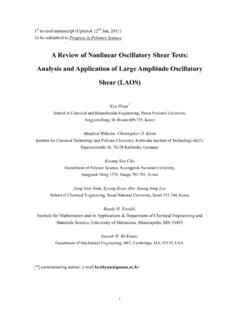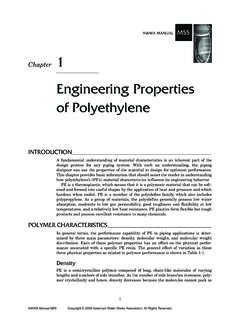Transcription of MECHANICAL PROPERTIES OF MATERIALS - MIT
1 MECHANICAL PROPERTIES OF MATERIALSD avid Roylance20082 Contents1 Uniaxial MECHANICAL StiffnessinTension-Young ThePoissonEffect .. ShearingStressesandStrains .. Stress-StrainCurves .. Problems .. 232 Thermodynamics of MECHANICAL EntropicResponse .. Problems .. MATERIALS .. Problems .. 484 General Concepts of Stress and Kinematics:theStrain Equilibrium: the Stress ConstitutiveRelations .. Problems .. 785 Yield and Plastic MultiaxialStressStates .. TheDislocationBasisofYieldandCreep .. Kinetics of Creep in Crystalline MATERIALS .. Problems .. AtomisticsofCreepRupture.
2 FractureMechanics-theEnergy-BalanceAppro ach .. TheStressIntensityApproach .. Fatigue .. Problems ..128 Chapter 1 Uniaxial MECHANICAL ResponseThis chapter is intended as a review of certain fundamental aspects of mechanics of MATERIALS , usingthe material s response to unidirectional stress to provide an overview of MECHANICAL propertieswithout addressing the complexities of multidirectional stress states. Most of the chapter willrestrict itself to small-strain behavior, although the last section on stress-strain curves will previewmaterial response to nonlinear, yield and fracture behavior as Tensile Strength and Tensile StressPerhaps the most natural test of a material s MECHANICAL PROPERTIES is thetension test,in whicha strip or cylinder of the material , having lengthLand cross-sectional areaA, is anchored at oneend and subjected to an axial loadP a load acting along the specimen s long axis at theother.
3 (See Fig. ). As the load is increased gradually, the axial deflection of the loaded endwill increase also. Eventually the test specimen breaks or does something else catastrophic, oftenfracturing suddenly into two or more pieces. ( MATERIALS can fail mechanically in many differentways; for instance, recall how blackboard chalk, a piece of fresh wood, and Silly Putty break.) Asengineers, we naturally want to understand such matters as how is related toP, and what ultimatefracture load we might expect in a specimen of different size than the original one. As materialstechnologists, we wish to understand how these relationships are influenced by the constitution andmicrostructure of the : The tension of the pivotal historical developments in our understanding of material MECHANICAL proper-ties was the realization that the strength of a uniaxially loaded specimen is related to the magnitudeof itscross-sectional area.
4 This notion is reasonable when one considers the strength to arise from56 CHAPTER 1. UNIAXIAL MECHANICAL RESPONSEthe number of chemical bonds connecting one cross section with the one adjacent to it as depicted inFig. , where each bond is visualized as a spring with a certain stiffness and strength. Obviously,the number of such bonds will increase proportionally with the section s area1. The axial strengthof a piece of blackboard chalk will therefore increase as thesquareof its diameter. In contrast,increasing thelengthof the chalk will not make it stronger (in fact it will likely become weaker,since the longer specimen will be statistically more likely to contain a strength-reducing flaw.)
5 Figure : Interplanar bonds (surface density approximately 1019m 2).When reporting the strength of MATERIALS loaded in tension, it is customary to account for theeffect of area by dividing the breaking load by the cross-sectional area: f=PfA0( )where fis theultimate tensile stress,often abbreviated as UTS,Pfis the load at fracture, andA0is the original cross-sectional area. (Some MATERIALS exhibit substantial reductions in cross-sectionalarea as they are stretched, and using the original rather than final area gives the so-callengineeringstrength.) The units of stress are obviously load per unit area, N/m2(also called Pascals, or Pa)in the SI system and lb/in2(or psi) in units still used commonly in the United many design problems, the loads to be applied to the structure are known at the outset, and we wishto compute how much material will be needed to support them.
6 As a very simple case, let s say we wish touse a steel rod, circular in cross-sectional shape as shown in Fig. , to support a load of 10,000 lb. Whatshould the rod diameter be?Directly from Eqn. , the areaA0that will be just on the verge of fracture at a given loadPfisA0=Pf fAll we need do is look up the value of ffor the material , and substitute it along with the value of 10,000lb forPf, and the problem is number of MATERIALS PROPERTIES are listed in theMaterials Properties2module, where we find the UTSof carbon steel to be 1200 MPa. We also note that these PROPERTIES vary widely for given MATERIALS dependingon their composition and processing, so the 1200 MPa value is only a preliminary design estimate.
7 In lightof that uncertainty, and many other potential ones, it is common to include a factor of safety in the1 The surface density of bondsNScan be computed from the material s density ,atomicweightWaand Avogadro snumberNAasNS=( NA/Wa)2/3. Illustrating for the case of iron (Fe):NS= 23= 1015atomscm2NS 1015atomcm2is true for many TENSILE STRENGTH AND TENSILE STRESS7 Figure : Steel rod supporting a 10,000 lb Selection of an appropriate factor is an often-difficult choice, especially in cases where weight or costrestrictions place a great penalty on using excess material . But in this case steel is relatively inexpensiveand we don t have any special weight limitations, so we ll use a conservative 50% safety factor and assumethe ultimate tensile strength is 1200/2 = 600 now have only to adjust the units before solving for area.
8 Engineers must be very comfortable withunits conversions, especially given the mix of SI and older traditional units used today. Eventually, we lllikely be ordering steel rod using inches rather than meters, so we ll convert the MPa to psi rather thanconvert the pounds to Newtons. Also usingA= d2/4 to compute the diameter rather than the area, wehaved= 4A = 4Pf f= 4 10000(lb) 600 106(N/m2) 10 4 lb/in2N/m2 12= inWe probably wouldn t order rod of exactly in, as that would be an oddball size and thus too 3/8 ( in) would likely be a standard size, and would be acceptable in light of our conservativesafety the specimen is loaded by an axial forcePless than the breaking loadPf,thetensile stressis defined by analogy with Eqn.
9 As =PA0( )The tensile stress, the force per unit area acting on a plane transverse to the applied load, is afundamental measure of the internal forces within the material . Much of Mechanics of Materialsis concerned with elaborating this concept to include higher orders of dimensionality, working outmethods of determining the stress for various geometries and loading conditions, and predictingwhat the material s response to the stress will engineering applications, notably aerospace vehicles, require MATERIALS that are both strong andlightweight. One measure of this combination of PROPERTIES is provided by computing how long a rod of thematerial can be that when suspended from its top will break under its own weight (see Fig.)
10 Here thestress is not uniform along the rod: the material at the very top bears the weight of the entire rod, but thatat the bottom carries no load at compute the stress as a function of position, letydenote the distance from the bottom of the rod andlet the weight density of the material , for instance in N/m3, be denoted by . (The weight density is relatedto the mass density [kg/m3]by = g,whereg= the acceleration due to gravity.) The weightsupported by the cross-section atyis just the weight density times the volume of materialVbelowy:8 CHAPTER 1. UNIAXIAL MECHANICAL RESPONSEF igure : Circular rod suspended from the top and bearing its own (y)= V= AyThe tensile stress is then given as a function ofyby Eqn.











